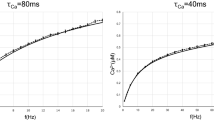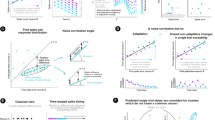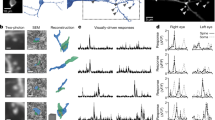Abstract
The strength of the connection between two neurons can be modified by activity, in a way that depends on the timing of neuronal firing on either side of the synapse1,2,3,4,5,6,7,8,9,10. This spike-timing-dependent plasticity (STDP) has been studied by systematically varying the intervals between pre- and postsynaptic spikes. Here we studied how STDP operates in the context of more natural spike trains. We found that in visual cortical slices the contribution of each pre-/postsynaptic spike pair to synaptic modification depends not only on the interval between the pair, but also on the timing of preceding spikes. The efficacy of each spike in synaptic modification was suppressed by the preceding spike in the same neuron, occurring within several tens of milliseconds. The direction and magnitude of synaptic modifications induced by spike patterns recorded in vivo in response to natural visual stimuli were well predicted by incorporating the suppressive inter-spike interaction within each neuron. Thus, activity-induced synaptic modification depends not only on the relative spike timing between the neurons, but also on the spiking pattern within each neuron. For natural spike trains, the timing of the first spike in each burst is dominant in synaptic modification.
This is a preview of subscription content, access via your institution
Access options
Subscribe to this journal
Receive 51 print issues and online access
$199.00 per year
only $3.90 per issue
Buy this article
- Purchase on Springer Link
- Instant access to full article PDF
Prices may be subject to local taxes which are calculated during checkout




Similar content being viewed by others
References
Levy, W. B. & Steward, O. Temporal contiguity requirements for long-term associative potentiation/depression in the hippocampus. Neuroscience 8, 791–797 (1983).
Gustafsson, B., Wigstrom, H., Abraham, W. C. & Huang, Y. Y. Long-term potentiation in the hippocampus using depolarizing current pulses as the conditioning stimulus to single volley synaptic potentials. J. Neurosci. 7, 774–780 (1987).
Markram, H., Lubke, J., Frotscher, M. & Sakmann, B. Regulation of synaptic efficacy by coincidence of postsynaptic APs and EPSPs. Science 275, 213–215 (1997).
Debanne, D., Gahwiler, B. H. & Thompson, S. M. Long-term synaptic plasticity between pairs of individual CA3 pyramidal cells in rat hippocampal slice cultures. J. Physiol. (Lond) 507, 237–247 (1998).
Zhang, L. I., Tao, H. W., Holt, C. E., Harris, W. A. & Poo, M. A critical window for cooperation and competition among developing retinotectal synapses. Nature 395, 37–44 (1998).
Bi, G. Q. & Poo, M. M. Synaptic modifications in cultured hippocampal neurons: dependence on spike timing, synaptic strength, and postsynaptic cell type. J. Neurosci. 18, 10464–10472 (1998).
Egger, V., Feldmeyer, D. & Sakmann, B. Coincidence detection and changes of synaptic efficacy in spiny stellate neurons in rat barrel cortex. Nature Neurosci. 2, 1098–1105 (1999).
Feldman, D. E. Timing-based LTP and LTD at vertical inputs to layer II/III pyramidal cells in rat barrel cortex. Neuron 27, 45–56 (2000).
Nishiyama, M., Hong, K., Mikoshiba, K., Poo, M. M. & Kato, K. Calcium stores regulate the polarity and input specificity of synaptic modification. Nature 408, 584–588 (2000).
Boettiger, C. A. & Doupe, A. J. Developmentally restricted synaptic plasticity in a songbird nucleus required for song learning. Neuron 31, 809–818 (2001).
Kempter, R., Gerstner, W. & van Hemmen, J. L. Hebbian learning and spiking neurons. Phys. Rev. E 59, 4498–4514 (1999).
Roberts, P. D. Computational consequences of temporally asymmetric learning rules: I. Differential hebbian learning. J. Comput. Neurosci. 7, 235–246 (1999).
Song, S., Miller, K. D. & Abbot, L. F. Competitive Hebbian learning through spike-timing-dependent synaptic plasticity. Nature Neurosci. 3, 919–926 (2000).
Somogyi, P., Tamas, G., Lujan, R. & Buhl, E. H. Salient features of synaptic organisation in the cerebral cortex. Brain Res. Rev. 26, 113–135 (1998).
Tsodyks, M. V. & Markram, H. The neural code between neocortical pyramidal neurons depends on neurotransmitter release probability. Proc. Natl Acad. Sci. USA 94, 719–723 (1997).
Varela, J. A. et al. A quantitative description of short-term plasticity at excitatory synapses in layer II/III of rat primary visual cortex. J. Neurosci. 17, 7926–7940 (1997).
Zucker, R. S. Calcium- and activity-dependent synaptic plasticity. Curr. Opin. Neurobiol. 9, 305–313 (1999).
Zorumski, C. F. & Thio, L. L. Properties of vertebrate glutamate receptors: calcium mobilization and desensitization. Prog. Neurobiol. 39, 295–336 (1992).
Stuart, G. J. & Sakmann, B. Active propagation of somatic action potentials into neocortical pyramidal cell dendrites. Nature 367, 69–72 (1994).
Malenka, R. C. & Nicoll, R. A. Long-term potentiation—a decade of progress? Science 285, 1870–1874 (1999).
Lisman, J. E. & Zhabotinsky, A. M. A model of synaptic memory: a CaMKII/PP1 switch that potentiates transmission by organizing an AMPA receptor anchoring assembly. Neuron 31, 191–201 (2001).
Senn, W., Markram, H. & Tsodyks, M. An algorithm for modifying neurotransmitter release probability based on pre- and postsynaptic spike timing. Neural Comput. 13, 35–67 (2001).
Rao, R. P. & Sejnowski, T. J. Spike-timing-dependent hebbian plasticity as temporal difference learning. Neural Comput. 13, 2221–2237 (2001).
Yao, H. & Dan, Y. Stimulus timing-dependent plasticity in cortical processing of orientation. Neuron 32, 315–323 (2001).
Dobrunz, L. E. & Stevens, C. F. Response of hippocampal synapses to natural stimulation patterns. Neuron 22, 157–166 (1999).
Connors, B. W. & Gutnick, M. J. Intrinsic firing patterns of diverse neocortical neurons. Trends Neurosci. 13, 99–104 (1990).
Stanley, G. B., Li, F. F. & Dan, Y. Reconstruction of natural scenes from ensemble response in the lateral geniculate nucleus. J. Neurosci. 19, 8036–8042 (1999).
van Rossum, M. C., Bi, G. Q. & Turrigiano, G. G. Stable Hebbian learning from spike timing-dependent plasticity. J. Neurosci. 20, 8812–8821 (2000).
Acknowledgements
We thank K. Djupsund for help in recording natural spike trains, and J. Long, M. Frerking and R. S. Zucker for discussions. This work was supported by grants from the National Science Foundation and National Eye Institute. R.C.F. is a recipient of the Howard Hughes Predoctoral Fellowship.
Author information
Authors and Affiliations
Corresponding author
Ethics declarations
Competing interests
The authors declare that they have no competing financial interests
Rights and permissions
About this article
Cite this article
Froemke, R., Dan, Y. Spike-timing-dependent synaptic modification induced by natural spike trains. Nature 416, 433–438 (2002). https://doi.org/10.1038/416433a
Received:
Accepted:
Issue Date:
DOI: https://doi.org/10.1038/416433a
This article is cited by
-
Stability against fluctuations: a two-dimensional study of scaling, bifurcations and spontaneous symmetry breaking in stochastic models of synaptic plasticity
Biological Cybernetics (2024)
-
Ultrafast light targeting for high-throughput precise control of neuronal networks
Nature Communications (2023)
-
Delay-dependent transitions of phase synchronization and coupling symmetry between neurons shaped by spike-timing-dependent plasticity
Cognitive Neurodynamics (2023)
-
Coherence resonance and stochastic synchronization in a small-world neural network: an interplay in the presence of spike-timing-dependent plasticity
Nonlinear Dynamics (2023)
-
Hardware Spiking Neural Networks with Pair-Based STDP Using Stochastic Computing
Neural Processing Letters (2023)
Comments
By submitting a comment you agree to abide by our Terms and Community Guidelines. If you find something abusive or that does not comply with our terms or guidelines please flag it as inappropriate.



